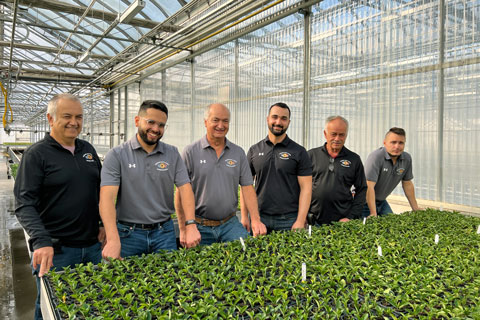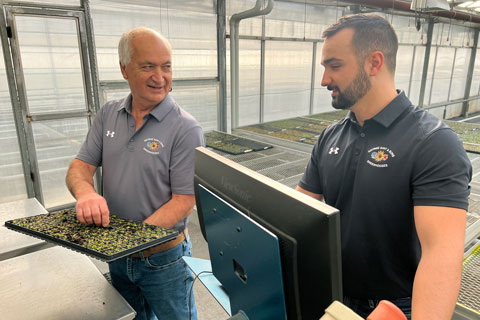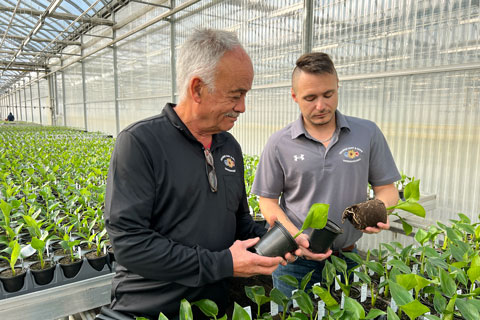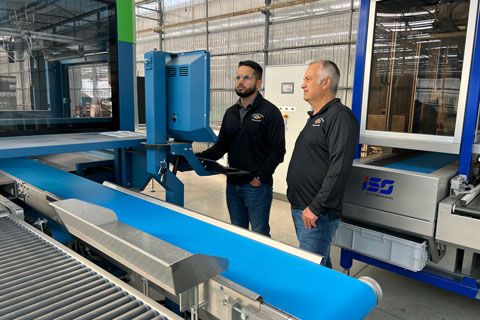12/1/2024
Preserving the Past & Focusing on the Future
Jennifer Zurko

If you didn’t know anything about George Sant & Sons Greenhouses, the first time you walk around their operation you’d probably think they were a newer business, with all of the modern technology and upgraded structures. But, in reality, it’s a 78-year-old company that has a long history in its suburban Toronto community.
Pictured: The third and fourth generations of Sants. From left: Ron, Miguel, Rick, Eric, Dan and Mark.
Currently, the business is run by brothers Dan, Rick and Ron—the third generation of Sants. But also playing a major part are their sons—Mark, Eric and Miguel—who are continuing the legacy that George (or “Nannu,” as they called him) instilled in their fathers that’s being passed down. This includes taking risks, making the hard decisions and knowing when it’s time to pivot.
It’s this ambition of embracing change while staying true to their history that’s made the Sants successful. I wanted to know how they’ve been able to manage that balancing act in a volatile industry like horticulture, so I flew a couple of hours over the border to ask.
From Malta to market
In 1912, Angelo Sant left his tiny island homeland of Malta off the coast of Sicily and headed west for a fresh start. He served as a marine merchant during World War I, and since both Malta and Canada were under British rule at the time, it was easy for Angelo to emigrate. He ended up finding work near Toronto and settled there to start a family.
After the end of the second World War, Angelo and his son George bought 100 acres of farmland to grow vegetables. They would start the vegetables in a small greenhouse they built on the property that they would transplant in the fields and then sell at the Toronto Food Terminal, which is like a local farmers market.
 Pictured: Father Rick (left) and son Eric.
Pictured: Father Rick (left) and son Eric.
Angelo and George ran the business together for a while, then decided to branch off to do their own thing, splitting the farm 50/50. George’s younger brother Frank ended up buying Angelo’s portion of the farm. They both grew and sold vegetables, but eventually George started integrating some flower production into his operation. As he was expanding with vegetables and flowers, his sons—Dan, Rick and Ron—came on board to help George run the business. George Sant & Sons Greenhouses was made official.
In the 1980s, George’s sons took over the company and immediately started investing in new equipment and structures. The two parts of the business (vegetables and flowers) grew substantially for over a decade—to the point where Dan, Rick and Ron were having a hard time juggling both. So after a few bad years with the vegetable crop, they decided to drop them and concentrate on the ornamental plants part of the business.
It was a luxury they could afford because George’s mantra of constantly maintaining the highest quality provided the means for the business to keep growing. There was big demand for his plants, so George kept putting up greenhouses to meet that demand.
“That’s how we grew,” said Dan. “It got so big that we couldn’t do both [vegetables and flowers].”
“And you had no control of [the vegetables],” Ron said. “Every year was a gamble and the greenhouse side was consistent. We knew we were going to make some money [with flowers] unless we had a disaster.”
 Pictured: Father Dan (left) and son Mark.
Pictured: Father Dan (left) and son Mark.
The timing was right because the ’90s were a change cycle for horticulture with all of the new innovations being introduced. It was during the birth of the vegetative side of the industry, but also the first iterations of transplanters and improved plug technology that allowed growers to branch out and offer more products to their customers.
This was when the Sants decided to get into growing unrooted cuttings, which provided a way to have their greenhouses running all year round. Once that happened, it opened the door to other opportunities—one that pushed their business even further: the partnership with Ball to be its exclusive supplier in Canada. And Sant has been one of Ball’s “Gold Suppliers” going on over three decades.
Growing for quality
Since the advent of the unrooted cutting, the Sants have been continuing to build their company, splitting it into two separate segments: young plants for the supplier side, and finished plants for their IGC and landscape customers.
Currently, about 65% of the business is from young plants, but the Sants have been able to maintain their finished plant business by continuing to practice George’s philosophy of always focusing on quality.
“A lot of our products we sell at a higher price point,” explained Miguel. “We can only do that because of the quality. There are certain things in our finished line that is unique to our business. It’s not something that you’re going to get at other growers.”
“That was Nannu’s saying: If you wouldn’t buy it, don’t put it on the rack,” said Dan.
Ron said a majority of the growth they’ve been experiencing during the last 10 years has been on the young plant side, which has allowed them to upgrade their growing structures and invest in new technology (more on that in a bit). In turn, they can continue to provide their finished plant customers with the best quality and service.
 Pictured: Miguel Sant (left) working on their new CuttingEdge transplanter while dad Ron looks on.
Pictured: Miguel Sant (left) working on their new CuttingEdge transplanter while dad Ron looks on.
The Sants admitted that there’s been some churn on the independent side in the Ontario area, with generations-long businesses closing up permanently. So the ability to offer the best gives them a leg up in a very competitive market and allows them to reap the rewards of a loyal customer base. It also helps them avoid having all of their eggs in one basket, so to speak.
“We don’t want to compete with our customers. If we’re going to sell young plants, we don’t want to be the biggest competition for selling finished as well,” explained Ron. “So we still want to sell finished, but we don’t want to be a big player in it.”
“We did the Costco thing and realized the little guy is important, easier to deal with, and it’s the little guy that got you where you are today,” said Dan. “And we’re sort of back to where we were in the ’60s, like a small independent.”
Shifting with the trends
One aspect of the Sant legacy is the willingness to try new things and adapt to change. When the vegetables side was starting to become a liability, they made the decision to cut it out completely, even though it was originally what the business was founded on. When unrooted cuttings started taking over the industry, they got on board right away even though it was a totally new form and a different way of growing for them.
Today, the current trends are shifting to consumers having less space and less disposable income, especially with younger generations.
“When we grew up, people were buying plants and planting them in the garden and decorating around the house. Gardening was a bigger way of life,” said Ron. “I think now they’re buying more containerized product and it’s more decorating. So you see less and less stuff being planted in the ground.”
Ron’s son, Miguel—who himself is part of the Millennial generation—understands and acknowledges this shift in how people are using plants.
“With the younger generation, they’re more into tech or they’re into being inside, playing video games or watching TV,” he said. “So I think a big focus for the horticulture industry in general with non-consumable, non-necessity items is that there needs to be a culture change.”
His cousin Mark agreed. “Trends are kind of moving indoors rather than outdoors. The problem is young people can’t really afford homes to have a landscape. Trends are showing that more and more young people are living the city life, they can’t afford the suburban life. Especially during the COVID years, the industry—just in Canada—saw an 11% increase in indoor plants.”
This increase also accounts for some of their long-term customers coming to them with new requests. Miguel said one of the landscapers they’ve been doing business with for years asked for smaller indoor plants for a living wall they were creating for a building in downtown Toronto. They wanted a tropical setting with “Miami vibes,” so indoor foliage plants were what fit the bill.
Because of these new shifts and recent demands, the Sants are in the process of pivoting to expand their houseplant offering. Spearheaded by Mark and Miguel, they’ve been looking at what they can add to their lineup that makes sense in their production regime and for what their customers want, experimenting with different crops and varieties of indoor plants.
“It’s very much taking the same approach as our grandfather did or what [our fathers] did,” said Miguel. “But nowadays you can get on a computer and you can just search up what the trends are and what the sales are. You can look year-to-year to see where things are kind of moving towards and you can make more calculated decisions.”
Some of the market research that Mark and Miguel have found estimates that the houseplant segment could reach $24 billion in North America by 2031 and they want to be a part of that. Their assessment is that it’s worth the risk to jump into a whole new product category than to not take the chance and get left behind.
“I think you have to be willing to fail,” said Miguel. “If you don’t try, you’re never going to know what could have happened. And you’re going to get into a bit of decision paralysis because you’re saying, well, we could do that, we could do that or we could do this. But if you don’t try, you’re not going to know if it’s going to work.”
And they don’t just make the hard choices to shift markets, they also invest in new technology. George Sant & Sons was the first growing operation in North America to have one of the brand new CuttingEdge sticking machines from TTA this past spring. They also have a nanobubbler for their irrigation system and state-of-the-art LEDs in their production houses. And while I was there in early October they were in the process of retrofitting 2 acres of greenhouses with an Apex roof to alleviate problems with condensation and provide better venting for snow loads. So the Sants are never resting on their laurels.
A future for generations
It was never a given that all of them were going to be involved in the business. George actually had five sons and only three of them worked alongside him. And Dan, Rick and Ron have other children that will pursue other professions. But there was never any pressure for anyone to be one of the sons in George Sant & Sons—they came on board because it was the best path to take.
Dan and Rick went to technical school, learning automotive and electrical. And Rick and Ron graduated from the University of Guelph with degrees in Horticulture. But they all cut their teeth in the greenhouse growing up.
“Dad was a hell of a teacher,” said Dan. “He spent time teaching us, and if you didn’t do it right, you had to do it all over again. He was aggressive and ambitious and he made us that way, as well. And we had to prove it to him.”
Ron’s son Miguel actually earned a soccer scholarship to play in college, so even though he grew up in the business like his dad, his original plan wasn’t to be a permanent part of the business. But after being sidelined by an injury, Miguel decided to join the company without any pressure from his dad.
“He said, ‘If this isn’t something you want to do, don’t do it,’” said Miguel. “I wasn’t necessarily drawn to the business as a kid, so I didn’t really see it as a potential avenue. But I think sometimes you kind of need to go outside your comfort zone and you realize that the grass isn’t greener on the other side.”
At first, Miguel was doing myriad tasks that evolved into being in charge of new automation. He was with Ron when they first saw the CuttingEdge machine while they were traveling in Europe, and he’s the one who worked with TTA to set it up and get it running. He’s also the quality control liaison with their suppliers.
Dan’s son Mark has a similar story to his cousin Miguel—his original goal was to teach English and Literature. Then his college professors went on strike and Sant’s accounts receivables lady quit, so he came in to help. That was 15 years ago. Today, Mark handles seed production and managing their seasonal workforce program. Eric works out in the greenhouse as an assistant grower and repairs machinery.
When it comes down to it, all of the Sants wear different hats, pitching in when it’s needed. But each of them bring their own strengths and expertise to the business.
“That goes back to our dad. He gave each of us our own areas to work,” said Rick. “I guess he looked at us and saw where our strong points were. But we all cover each other.”
There will come a time when the fourth generation will be fully in charge of George Sant & Sons Greenhouses, but for now, the fathers and sons all work alongside each other. I’ve spent enough time with the Sant gentlemen to gauge all of their different personality traits. But regardless of any differences, all of them have the same goal: honor Nannu’s legacy while continuing to move the business into the future. The Sants all agree that if they continue to focus on constantly adapting, quality and service, they’ll maintain their success.
“When Dad used to grow vegetables he had a big Q on the side of our logo and that stood for quality,” said Rick. “Every business has to realize you’re going in one direction toward your goal. So you don’t sweat the small stuff and you just focus on where you want the business to go.” GT